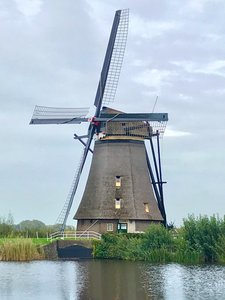Advertisement
Published: April 25th 2023

 Kinderdijke Windmill
Kinderdijke Windmill
Kinderdijke Windmill (Molen).
Mill Network at Kinderdijk-Elshout UNESCO World Heritage Site.
"The outstanding contribution made by the people of the Netherlands to the technology of handling water is admirably demonstrated by the installations in the Kinderdijk-Elshout area. Construction of hydraulic works for the drainage of land for agriculture and settlement began in the Middle Ages and have continued uninterruptedly to the present day. The site illustrates all the typical features associated with this technology – dykes, reservoirs, pumping stations, administrative buildings and a series of beautifully preserved windmills".
IMG_1535If The Netherlands is known as the land of windmills, then Kinderdijk is
the place to see them in operation. Windmills in the Netherlands are typically used as water pumps to keep the polders dry.
Viking Sigrun arrived here late in the afternoon, around 3:45 p.m. There are 19 windmills to see here, the earliest dating to the 17th century. They are positioned along two rows. The Overwaard's wooden mills and Nederwaard's brick mills use wind power to move water from the polders to the basins. The surrounding land is below sea level. Water is pumped into the River Lek.
As we disembarked, we joined a local guide for a tour. It was late on a blustery and chilly day, and there were few visitors about except our cruise group. The information kiosk was closed, but the visitor café and gift shop were open. Our group first visited the Wisboom Pumping Station. Since 1868, the pumping station has assisted the windmills in pumping water by using steam, then electrical powered pumps. We saw a film on Kinderdijk and its contribution to water management. The pumping station originally used steam power, but the later electrical pumping machinery was on display.

 Polder House
Polder House
Polder house, dating from 1648, the front of which was renovated in 1918. The rear has high windows with classic pediments; on the front a Renaissance portal with carved crests and curved pediment, 1644. Molenstraat 238, Kinderdijk.
DSC_0929After the pumping station, there was time to walk along the path connecting the mills and enjoy the scenery. One mill was open to visit inside. Some passengers had taken an optional scenic cruise through the windmills. The mills have been supplanted as the primary pumping mechanism for the polders, but they certainly form an attractive ensemble.
The Mill Network at Kinderdijk-Elshout is a UNESCO World Heritage Site.
After our visit to Kinderdijk, Viking Sigrun sailed for Amsterdam and the conclusion of the cruise.
Advertisement
Tot: 0.103s; Tpl: 0.023s; cc: 19; qc: 30; dbt: 0.0515s; 1; m:domysql w:travelblog (10.17.0.13); sld: 1;
; mem: 1.2mb

 Kinderdijke Windmill
Kinderdijke Windmill
 Polder House
Polder House















































D MJ Binkley
Dave and Merry Jo Binkley
Serenity
Lovely even on a cloudy day.